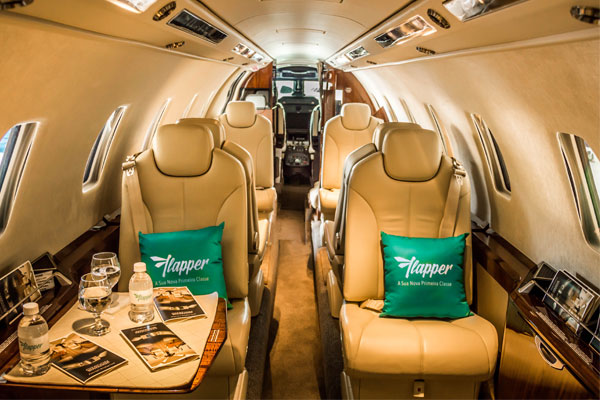The boutique private airlines started in the U.S. in early 2000s as a response to growing consumer demand for business aviation services serving second-tier airports.
You have probably heard about boutique hotels while searching for your next holiday accommodation; with personalized service and unique interiors, they constitute a worthy alternative to well-known 5-star hotel chains. But boutique private airlines?
For a moment, think about private aviation and its benefits. Comfort? Efficiency? High-quality service? Since their very inception in the second half of the last century, private aviation services revolutionized the aviation sector by offering the possibility to fly to thousands of new airports at flexible schedule, all wrapped under a Premium customer support concept. But this came at a heavy price tag of either a charter flight or a fractional ownership program.
The boutique airline model embraces similar traits but at a fraction of price. Often referred to as “commuter airlines”, such services trade privacy and flexibility for the benefit of flying on executive aircraft on scheduled routes, often unavailable for commercial aviation. The service quality and the overall swiftness of the process match or even exceed those of usual air charter companies.
“With further democratization of commercial aviation, there has been less and less space for customized services and this gap can be effectively filled by commuter airlines”, says Paul Malicki, CEO of Brazil-based Flapper. “However, we consider it more as just an alternative to flying private (or commercial)” – continued Malicki – “Since we fly on routes which don’t exist on commercial sector, we effectively increase the size of the existing sector”.
The Key Players
The boutique private airlines started in the U.S. in early 2000s as a response to growing consumer demand for business aviation services serving second-tier airports. High economic activity combined with an ever-increasing penetration of mobile, as well as existing airport infrastructure, prompted the launch of first venture-backed startups and government Essential Air Service (EAS) programs. Using a homogenous fleet of (mostly) light aircraft, there emerged multiple players offering membership programs, crowdsourced flights, flight packages or simply selling individual seats.
Here are some of the top players worldwide in 2019, by alphabetical order:
Aero (Mediterranean, private jet by-the-seat)
Focused on high-season luxury destinations, such as Ibiza and Mykonos, the company offers one-way flight in heavy jets at around €650. Its fleet consists of Bombardier CRJ200 specially fitted for 16 passengers.
Blade (U.S., commuter & pool)
Blade operates scheduled- and crowdsourced flights in the Northeast of the US, as well as in Los Angeles, San Francisco and (soon-to-be-launched) Mumbai in India. Its partner fleet is composed of helicopters Bell and S76, as well as turbo-propellers PC-12 and Caravan. It currently runs an Urban Air Mobility initiative in numerous large cities with continuous flights to and from main airports.
Boutique Air (U.S., regional airline)
An air carrier providing scheduled services in 17 different states under the EAS program. The company uses a 32-strong fleet of executive turboprops Pilatus PC-12 and Beechcraft King Air 350 and flies to as many as 30 different destinations.
Flapper (Brazil, commuter airline)
Founded in 2016, Flapper is the first on-demand executive aviation company in Brazil, offering shared flights and air charter services. The company operates two routes in the Southeast of Brazil, with up to 10 high-season destinations across the country.
Harbour Air (Canada, regional airline)
Founded back in 1982 in British Columbia, the airline operates daily flights connecting Vancouver with Lower Mainland, Vancouver Island, the Gulf Islands, the Sunshine Coast and Whistler. The company relies on the fleet of 40 Canadian-built Havilland Beaver and Otter aircraft.
La Compagnie (Paris, regional airline)
The company operates scheduled flights between Paris, New York and Nice aboard a custom-made 100% business-class cabin, with 19 rows and 74- to 76 seats arranged in 2×2 rows. The fleet is composed of Boeing 757 and Airbus A321neo.
SurfAir (U.S., commuter membership airline)
The company offers an all-you-can-fly Netflix-style membership program in the US state of California. Customers pay USD 1950 to gain access to the modern fleet of Swiss-made Pilatus PC-12 turbo-propellers.
WheelsUp (U.S., membership airline)
This fast-growing NY-based “unicorn” offers multiple membership tiers which allows its customers to gain access to discounted hourly rates for its King Air 350 fleet. Customers can book individual seats or charter an aircraft.
Tradewind (U.S. and Canada, regional airline)
Headquartered in Connecticut and with bases at Westchester County Airport in New York and San Juan International Airport in Puerto Rico, Tradewind operates scheduled services throughout the U.S. and Caribbean, powered by Pilatus and Citation CJ3 aircraft.
The Bottom-line
Running on a customer-centric model, boutique airlines fill in the gap between commercial- and private aviation, effectively differentiating themselves from any other segment on the market. And although flying with strangers has received some criticism from the more conservative representatives of the sector, with numerous such projects now active in different parts of the world, we can boldly assume that boutique private airlines are here to stay. Their expansion is likely to be fueled by the growing impact of technology and sharing economy, hence boosting passenger demand in airline sector.








































































































































































































